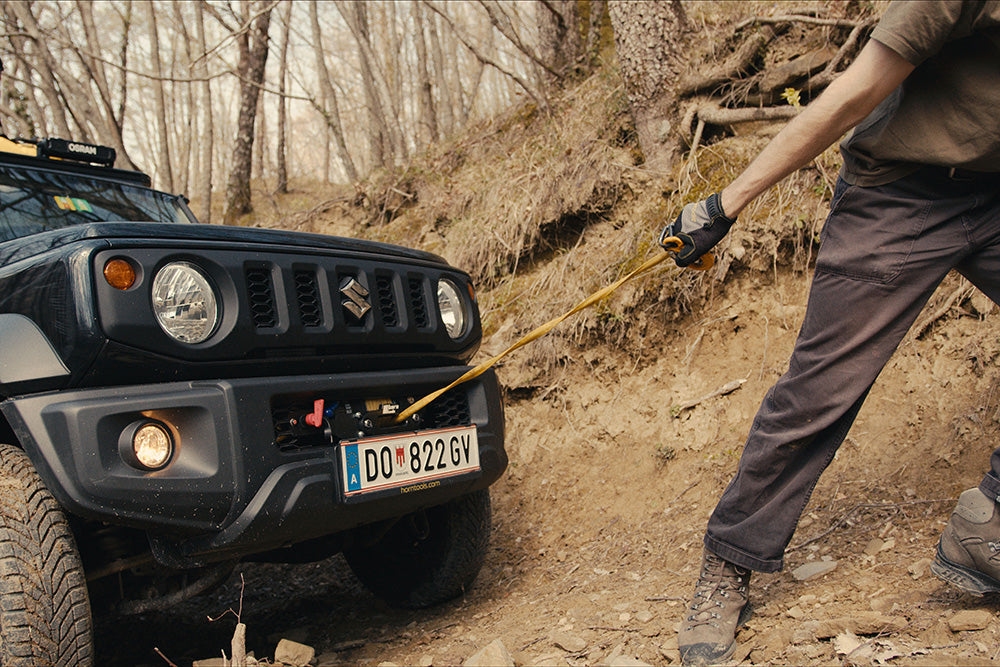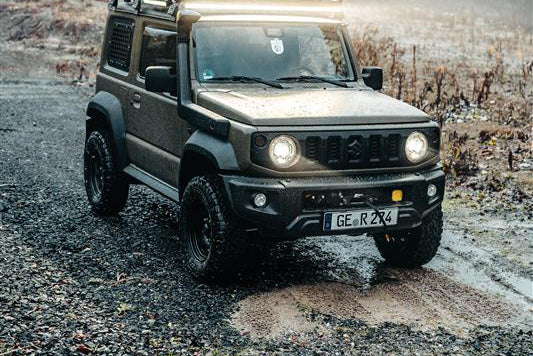Key Takeaways
- Safe handling of the cable winch: Proper preparation, clear procedures and a safe distance are crucial.
- The right accessories count: tree straps, soft shackles, pulleys and rope extensions ensure safe and gentle rescue.
- Controlled work: Even pulling force instead of jerky pulling – for maximum safety and material protection.
- Regular inspection & care: Clean, check and properly store the rope and accessories after each use.
- horntools Recovery Kits: From the compact Basic Set to the comprehensive Recovery Kit Plus – the right recovery kit for every application.
1. Preparation is everything – safety begins before deployment
Before using the cable winch, it is important to stay calm and assess the situation carefully.
- Wear protective equipment: Always wear gloves to avoid injuries from dirt, metal fibers, or rope friction.
- Secure the danger zone: No one should be in the pulling area of the rope – if it breaks, it can snap back dangerously.
- Check stability: The towing vehicle must be stable, especially on slopes or loose ground.
- Use freewheel: Always use freewheel when unwinding the rope to protect the winch and motor.
 Image: horntools cable winch in use in the Sahara
Image: horntools cable winch in use in the Sahara
2. The right accessories for a safe rescue
A well-thought-out rescue kit is the basis for safe work.
horntools offers various recovery kits – from the Recovery Kit Basic for occasional recoveries to the Recovery Kit Plus for regular off-road use.
Depending on the set, the following are included:
- Rescue gloves – for secure grip and protection
- Tree strap – protects trees and anchor points
- Soft shackle – light, safe and gentle on the rope
- Rope extension – if the winch rope is too short
- Pulley – doubles the pulling force and improves the pulling angle
The Plus Sets are delivered in the robust, waterproof horntools Expedition Bag delivered – easy to clean and ideal for transport on or in the vehicle.
Tip: If you want to know more about choosing the right rope, read our Adventurer Magazine article Deflection pulley for the cable winch: steel rope or plastic rope
3. Step-by-step: Recover the vehicle safely
- Attaching the tree strap: Wrap the strap around the tree and secure it with a soft shackle. This protects both the tree and the material.
- Connecting a soft shackle: Loosen the knot slightly, pull it through the eyelet, and close it. It will tighten itself under load.
- Attaching the winch hook: Never thread the rope directly through the strap or shackle – this weakens the rope and can lead to it breaking.
- Check the hook closure: The hook must always be completely closed before you build up tension.
- Keep the engine running: The engine should be running while the winch is in operation to keep the battery charged.
- Work in a controlled manner: Pull in short intervals to keep an eye on the vehicle movement and the rope path at all times.
Tip: With steel cables, an open hood provides additional protection against kickbacks in the event of a cable break. Synthetic cables are significantly safer in this case.
 Image: Rescue operation on Corsica with horntools equipment
Image: Rescue operation on Corsica with horntools equipment
4. During pulling – evenly and controlled
A successful rescue depends on control and sensitivity:
- Wind slowly: No jerky movements – rather work in short pulses.
- Check the rope path: The rope must not coil on one side. If pulling diagonally, adjust the anchor point or the steering direction if necessary.
- Secure the vehicle: Use the handbrake or wheel chocks to secure the vehicle if the cable breaks.
5. After the rescue – care and inspection
After use, the inspection follows – for maximum safety next time:
- Inspect the rope: Look for cracks, crushed areas, or flattened spots. If the rope becomes thinner in any spot, replace it immediately.
- Cleaning accessories: Clean the tree strap, soft shackle and pulley with water and let them dry.
- Wind the rope correctly: Roll it up loosely and store it safely on the drum.
- Mark the rope: A colored mark on the last layer shows when the next use ends.
This keeps your winch ready for use and safe at all times.
Conclusion: Security is no accident
A cable winch is a powerful tool – but only as safe as its user.
With the right accessories, careful preparation and regular maintenance, you can protect yourself and your vehicle.


Leave a comment
All comments are moderated before being published.
This site is protected by hCaptcha and the hCaptcha Privacy Policy and Terms of Service apply.